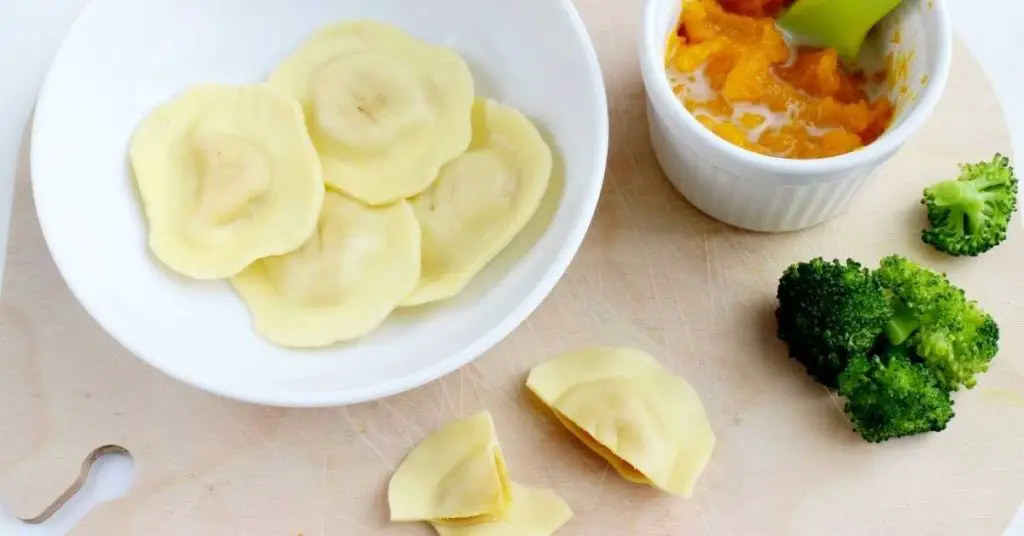This post will help you decide which weaning method to choose for your baby. Baby led weaning vs traditional weaning- we will look at advantages and disadvantages for each method as well as many other tips and information about baby weaning.
Our babies go through so many changes in a relatively short period of time. It’s incredible to watch and we marvel at each new thing that they do.
One important milestone that has us giddy with excitement but also a little anxious is weaning. How will my baby handle it? Is she allergic to something? What should I feed her? What if she chokes? What type of weaning should I go with? These are all questions that cross our minds as the big moment approaches.
Luckily for us, we live in the internet era where all the information is at our fingertips. We can read official recommendations, other parents’ experiences and ebooks written by professionals.
This post is meant to give you the information that you need on the two basic approaches (baby led weaning vs traditional weaning), and my experience with weaning as a mom of two. But before we take a look at each weaning method, the question is:
When should I start weaning?

The official recommendations from WHO and NHS are that babies should be given complementary food at around 6 months.
Our parents and grandparents would probably disagree with this since back then babies were given purres, juices and soups as young as 3 months (I was one of those babies, ouch my poor stomach). But now we know that it takes roughly 6 months for a child’s body to be ready to handle solids. This means that:
- Their digestive system is mature enough for solid food
- They stop pushing food out of their mouth with their tongue which is a protective reflex that babies have from when they are born to around 4-5 months that prevents them from choking
- They have developed enough hand mouth coordination that will allow them to take food to their mouth
Even though some babies will be ready to start eating solids at 5 ½ months, others closer to 7 months it is important to look for clear signs that your precious is ready to start his food journey.
What are the signs that the baby is ready for weaning?
It is so exciting to start feeding your little one solids. It’s a new chapter and your baby is growing. However, it is vital to be patient and only start when the baby is ready.
But how do you know she/he’s ready? Luckily your little one will give you clues when s/he is ready for the big step. Here are the signs that you should be looking out for:
- The baby can sit unassisted for a few seconds. S/he doesn’t have to be able to come to a sitting position on their own but be able to maintain this position for a little while when s/he is placed in it.
- The baby can take objects to his/her mouth
- S/he is visibly interested in food, not only being curious about it but insistently asking for whatever the parent is eating
- The tongue-thrust reflex is gone. This means that the baby will not push the food out with his/her tongue but rather successfully use the tongue to guide food to the back of the throat and swallow it.
Sometimes parents confuse babies chewing their fists, waking up more often during the night or asking for milk more often as signs that they should start feeding them solids. These are mostly normal behaviours for babies and not weaning signals.
For the safety of your baby and a happy, successful weaning, make sure that your baby exhibits all of the signs listed above.
Along with looking out for the readiness signs you also have to decide on what type of weaning you will go with. The basic choices are Traditional weaning or Baby-Led weaning.
Let’s take a quick look at each of them.
Traditional Weaning

Traditional weaning or spoon fed weaning is the most popular type of introducing solid foods. It’s most likely how you and I were weaned.
In this type of weaning, the baby is introduced to food in a pureed form, gradually progressing to finely chopped or mashed food and finally to finger food somewhere around 9 months of age. The baby is spoon-fed by the parent.
Advantages of traditional baby weaning
- The parent sees exactly how much the baby eats
- There is less gagging
- Less messy
- You can control what the baby eats (for example iron-rich foods)
Disadvantages to traditional baby weaning
- Babies may be overfed
- Preparing purees is time-consuming
- They don’t get much sensory experience from food (texture, colour, shape) since it’s all mashed up
- Feeding times are different since you feed the baby first and then eat yourself
Baby-Led Weaning (BLW)

With BLW your little one is in the driver’s seat when it comes to feeding. The puree period is skipped altogether and the baby eats finger food from the beginning with no help from the parent.
Because the baby actually picks up the food and takes it to his/her mouth it is important that s/he has good head control and hand-eye coordination.
BLW has been gaining a lot of popularity in the last 16 years or so and even though there are those who raise concerns about it, most parents who have gone down this path have had a positive experience.
Discover the best list of Baby Led Weaning Essentials
Advantages of baby-led weaning
- The baby gets to experiment with different textures, colours, tastes, gets to squeeze and manipulate the food.
- The baby can eat the same food as the rest of the family provided it is cut appropriately and doesn’t contain salt, sugar, strong spices or honey.
- The baby joins the family meal which encourages social interaction.
- The baby eats exactly the right amount of food
- Some studies show that BLW may reduce the chance of obesity later on
- Kids may grow up to be more adventurous eaters
Disadvantages of baby-led weaning
- It can get messy
- Parents don’t always know how much food has ended in the child’s stomach thus worrying about nutrients intake (especially iron)
- Worries about the baby choking can make the experience stressful for the parents
There is a third option for those who would like to offer their babies finger food from the beginning but they also want to have some control over what the baby eats. It’s called the Mixed Method and, as the name suggests, it’s a combination between the traditional method and BLW.
Babies are spoon-fed purees and given finger food from the beginning. This is the method that I used when I weaned my son and it was smooth sailing all the way. I didn’t necessarily cook especially for him but if, for example, we had cream veggie soup for lunch, I’d spoon-feed him (which is not part of the BLW philosophy).
The mixed method is (at least in my opinion) the best of both worlds:
- Babies get to practice manipulating finger food from the beginning
- Since they are also spoon-fed, they get the necessary nutrients
- Babies experiment and play with the different food textures
- The whole family can enjoy eating together
Of course, like the other two methods, the mixed method has its disadvantages like messiness and fear of choking (if you’re allowing the baby to feed by herself) or overfeeding and spending time making purees (if you are feeding the baby yourself).
Baby Led Weaning vs Traditional Weaning- What weaning method should I choose for my baby?
As you can see each method has both advantages and disadvantages. What matters is what you and your baby are comfortable with because ultimately this new chapter is supposed to be an exciting and happy one for both your little one and yourself.
So, I guess the answer to the dilemma baby led weaning vs purees is whichever method makes you feel comfortable. If you see that the baby isn’t doing well with chunks or you are terrified of choking, go with purees until s/he is ready. No method is better than the other. It’s what suits each family.
Whichever method you decide to use, remember that a happy, relaxed parent = a confident, calm baby.
As I mentioned above, I started giving my son complementary food at 6 months. We didn’t do the pure baby-led weaning method, rather we did a combination. To be honest, I was a little bit anxious at the beginning because I wasn’t sure that he would be able to handle finger food. But he did wonderfully. Since then I realised that our babies can do a lot more than we give them credit for. Have faith in your little munchkin and you will be surprised.
General safety tips
- One of the most important aspects of baby weaning that you should read about is the difference between gagging and choking.
- Gagging is the normal reflex that we all have when we introduce something at the back of the throat. It is our body’s way of keeping us from choking. In babies, this gagging point is located more to the front of the mouth than in an adult. It moves towards the back of the throat at around 8 months. That’s when you will notice less gagging. One thing to remember about gagging is that there is noise involved like coughing, gurgling, and sputtering. As scary as these may sound, it is normal and when there’s noise involved that means air goes through as well.
- Choking on the other hand is silent. The piece of food is fully or partially obstructing the baby’s airway and they’ll have trouble coughing and breathing. If this is the case you need to take action immediately.
Ideally enrol in a first-aid course, if that is not possible make sure to read any available materials or watch relevant videos.
- If you have allergies in your family watch out for those particular foods when you introduce them to your baby, although any food can cause allergies. The most common allergenic foods are: milk, eggs, fish and shellfish, nuts and peanuts, cereals that contain gluten, soya, some fruit and vegetables.
- Special attention must be given to foods that present a choking risk. We are talking about round food (cherry tomatoes, strawberries, grapes, olives etc) and food that contains stones and seeds. These must always be cut in half and the stones removed.
- Hard foods like nuts, peanuts, corn seeds should be offered around the age of three.
- Peanut butter should be spread on toast and not offered by spoon because it is “sticky.
- At the beginning of weaning offer the baby toast because normal bread has the risk of transforming into a ball of dough when eaten.
- The child should always eat in an upright position.
- Don’t offer food while the baby is distracted by gadgets, toys, other people etc
- Foods and ingredients that should be avoided at least in the first year are salt, sugar, honey, syrups, shark and swordfish (they have a high content of mercury), raw eggs, fish or shellfish, saturated trans fats (found in biscuits, cakes, cookies, crisps etc), dietetic products.

Final Thoughts
Introducing complementary food is such an exciting milestone. It is normal to be a little anxious about the new chapter but I can tell you from my own experience that everything will be fine.
Wait until the baby is ready to start on solids and from there, my advice is to give as much autonomy to your little one as possible.
Of course, you decide what food she eats, but allow her to try and feed herself, experiment and play with food. If you think that she hasn’t eaten anything and you are worried about that, by all means, you can spoon feed her.
It doesn’t have to be baby led weaning vs purees, rather you can take what best suits you and your baby from each of these weaning methods
Remember that this is a phase in your child’s life that should be celebrated and enjoyed.
- Use Everyday Objects to Teach Kids Science
- How to Teach Your Child Anger Management
- 7 Free STEM Activities for Kids
- Growth mindset examples for students
- Montessori at Home- Independent and Reliable Kids

Mom of two wonderful children, dedicated teacher and book lover.


I also used the mixed method and it worked well! My son has always been a great eater, and doesn’t have a problem with eating the meals I make.
My son is just two months old and his main food is breastmilk and little bit of formula when I am not available. Your post is very informative I like the led weaning is my favourite one.
Very helpful information, thank you for sharing! I have also used a mix of both methods with my babies and it has worked well so far.